New perspectives in dining: Nendo presents Colourful Shadows at Japan's Expo Milan 2015 Pavilion
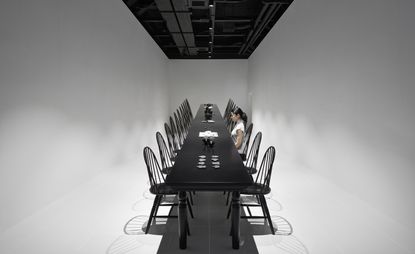
Hidden within the gridded timber walls of Atsushi Kitagawara Architects' Japan Pavilion at Expo Milano 2015, is a quiet all-white dining space conceived by the country's champion of design, Oki Sato's studio Nendo. Titled 'Colourful Shadows,' the work comprises a sloping black dining table, surrounded by a set of 24 matching chairs and laid with an array of black tableware, spanning the length of the 11m x 3m space. As visitors enter, the furniture gradually increases in height, creating a warped sense of perspective and encouraging guests to use the chairs as stepladders to get a closer look at the objects on display.
Correlating with the Expo's underlying theme of ‘Feeding the Planet, Energy for Life’, each of the 16 pieces of tableware were designed by the studio and produced via a different traditional Japanese craft or local industry. The exhibition has been deliberately designed in a monochrome palette so as to not distract from the intricacies of the craftsmens' work.
'In the novelist Junichiro Tanizaki’s essay In Praise of Shadows', says Nendo, explaining the thinking behind the show's title, 'there is a passage about eating a yokan [a traditional sweet made from black bean paste] in the dark in order to develop a keener palette. Just as in this exhibition, all information pertaining to colour has been removed to encourage the spectator to focus on other more essential aspects of the exhibited pieces.'

In the centre of the space, a sloping black dining table, surrounded by a set of 24 matching chairs, is laid with an intriguing array of 16 pieces of black tableware.
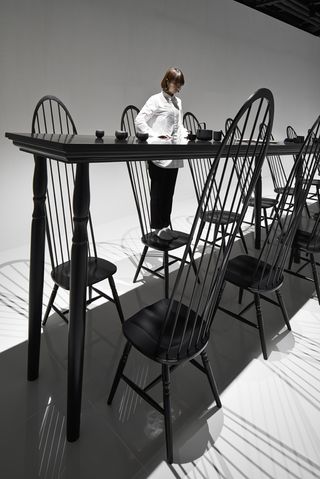
As visitors walk into the space, the furniture gradually increases in height – guests are encouraged to use the chairs as stepladders to get a closer look at the objects on display.
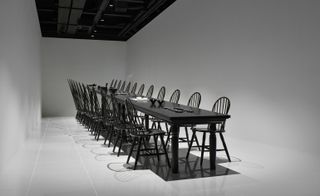
The perspective-bending dining space correlates with the Expo's underlying theme of ‘Feeding the Planet, Energy for Life’.
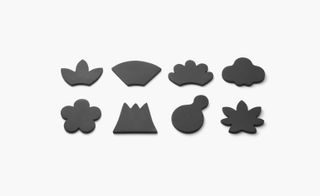
Sixteen pieces of black-coloured tableware were designed by the Japanese studio and produced via a different traditional Japanese craft or local industry – so as not to distract from the intricacies of the craftsmens' work, the pieces are all black. 'Tokoname-yaki' by Koyo (pictured). A set of Japanese confectionery-shaped coasters are produced using Tokoname-yaki – a type of reddish-brown ceramic ware chiefly produced in Tokoname, Aichi Prefecture.
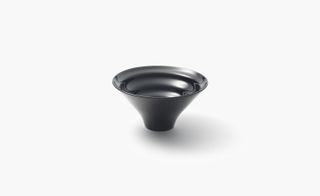
'Yamanaka-shikki' by Japan Crafts Oshima. Used to make this rippled bowl, Yamanaka-shikki is a type of lacquer ware which originated in the late 16th century in the Yamanaka Onsen (hot spring) region in Kaga, Ishikawa Prefecture.
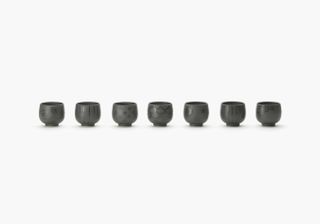
'Imari Arita-yaki' by Gen'emon Gama. Umekomon plum blossoms, stripes, checkers, and floral patterns have been hand drawn onto the matte surface of these 'ochoko' cups by skilled craftsmen in Arita, Saga Prefecture using a newly developed glossy glaze.
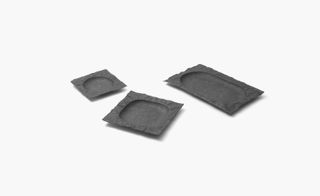
'Ozu-washi' by Ikazaki Shachu. In this piece, sumi, a black ink used in traditional calligraphy which is compatible with Japanese washi paper, has been mixed in to soften the paper, and then compressed to form the shape of a small plate.
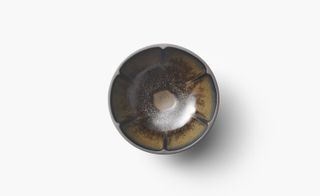
'Satsuma-yaki' by Tsukino-mushi. Incorporating the distinctive black used in traditional Satsuma earthenware – a colouration that comes from the iron in the clay and glaze – this bowl features a citrus fruit motif, a matt finish on the exterior and a glossy finish on the inside.
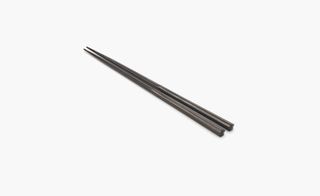
These pleated 'Wakasa-nuri' chopsticks by Hashikura Matsukan are designed to be more comfortable to hold in the hand.

This set of 'Wakasa-nuri' chopsticks by Hashikura Matsukan were made using a careful process of carving, polishing and lacquering.

'Oodate-magewappa' by Oodate Kougeisya. The 'Oodate-magewappa' is a wooden box, usually circular or oval in shape and made from bending cedar or cypress. With this particular item, the container has deliberately not been made into a complete cylinder so, depending on its size, it can be used as a chopstick holder, a toothpick holder, or a chopstick rest.
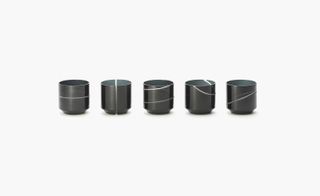
'Edo-kiriko' glassware, often cited as a local specialty of Tokyo, originated in 1834. This set of 'Edo-kiriko' glasses by Kimoto Glassware is made using a simple two-layered cylinder of transparent and black glass, etched with single horizontal or vertical cut.

The traditional Japanese 'masu', or box-measure, has been widely used for centuries as a cup from which to drink sake, and as a measuring device for various grains. This particular masu has been produced in collaboration with Kahei Yamada, an Edo-style woodwork craftsman who practices a sophisticated technique that dates back to the early Edo Period. The boxes' top and bottom have been tapered with diagonal carvings for easier stacking.
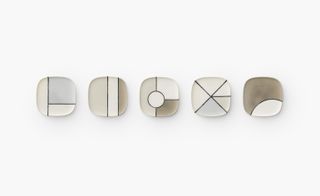
'Edo-sashimono' for Kahei Yamada. With a history of more than 1300 years, Mino-yaki is a type of pottery and porcelain from the Tono region in Gifu Prefecture. By combining this with the traditional technique of kintsugi, which is the art of repairing broken ceramic ware with a glue lacquer, three identically shaped but different-coloured plates have been cut and refitted to form these unique designs.

This matching teapot and cup by Gasen are made using 'Yamagata-imono', a type of cast-metal craft from Yamagata Prefecture, which has its roots stretching back to the mid Heian Period.
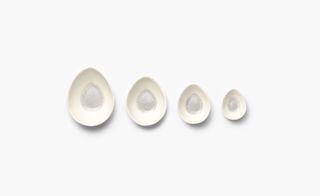
A set of four eggshaped bowls are made by Tsukino-mushi using Satsuma-yaki – a type of ceramic ware from Kagoshima Prefecture, originating in the times of Lord Toyotomi Hideyoshi.

A set of interlocking chopsticks made using Wakasa-nuri (lacquerware) by Hashikura Matsukan. For four centuries, the town of Obama in Fukui Prefecture, Japan, has manufactured lacquerware and is reknowned for its expertly crafted lacquered chopsticks.

These placemats are made from recycled shipping maps using a traditional luxury 8th century textile-making technique called Nishijin-ori, often woven to make obi belts for kimonos. Crafted by Hosoo, the traditional brocade is created from thinly cut strips of paper (in this case, shipping maps) that have been treated with lacquer or gold leaf.

Made from aluminium treated with a urethane baking finish this cutlery set is made by the craftsmen at TakataFactory who specilaisse in 'Takaoka-doki' – a type of cast metalwork specific to Takaoka in Toyama Prefecture.
Wallpaper* Newsletter
Receive our daily digest of inspiration, escapism and design stories from around the world direct to your inbox
-
 The Brazilian Forest House injects art into a modernist-inspired, contemporary design
The Brazilian Forest House injects art into a modernist-inspired, contemporary designThe Brazilian Forest House, designed in upstate São Paulo by FGMF, brings together nature and art
By Ellie Stathaki Published
-
 Waiting room inspo: Inside Studioutte’s cinematic Sala D’Attesa at Milan Design Week
Waiting room inspo: Inside Studioutte’s cinematic Sala D’Attesa at Milan Design WeekStudioutte’s Sala D’Attesa, staged in Nolo during Milan Design Week 2024, was a scenographic interior merging different design sensibilities
By Laura May Todd Published
-
 Bang & Olufsen’s Recreated Classics series continues with a CD player revival
Bang & Olufsen’s Recreated Classics series continues with a CD player revivalBang & Olufsen’s Beosystem 9000c music system brings the original digital compact disc format back to life and pairs it with the latest in speaker design
By Jonathan Bell Published
-
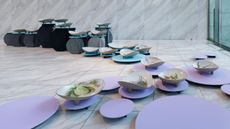 Designart Tokyo transforms the city into a museum of creativity
Designart Tokyo transforms the city into a museum of creativityDesignart Tokyo presents global design highlights through a series of exhibitions involving global creative talent and traditional Japanese craft
By Danielle Demetriou Last updated
-
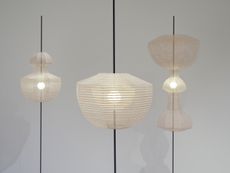 Nendo’s collaborations with Kyoto artisans go on view in New York
Nendo’s collaborations with Kyoto artisans go on view in New York‘Nendo sees Kyoto’ is on view at Friedman Benda (until 15 October 2022), showcasing the design studio's collaboration with six artisans specialised in ancient Japanese crafts
By Pei-Ru Keh Last updated
-
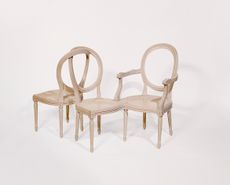 17 designers and artists reinterpret Dior's ‘Medallion’ chair
17 designers and artists reinterpret Dior's ‘Medallion’ chairThe Dior ‘Medallion’ chair project marks the French maison's most significant presence at Milan’s Salone del Mobile to date
By Nick Vinson - Art Direction Last updated
-
 Celebrating the beauty of Japanese carpentry tools
Celebrating the beauty of Japanese carpentry toolsNow on show at New York's Japan Society, ‘When Practice Becomes Form: Carpentry Tools from Japan' presents an overview of the techniques at the heart of Japanese wooden craftsmanship
By Pei-Ru Keh Last updated
-
 Designart Tokyo transforms the city into a living, multi-sensory museum
Designart Tokyo transforms the city into a living, multi-sensory museumThe third edition of the fair (18-27 October) showcases over 100 exhibitions across the Japanese capital
By Danielle Demetriou Last updated
-
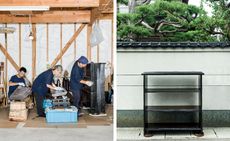 London designer Max Lamb takes a shine to the Japanese art of lacquerware
London designer Max Lamb takes a shine to the Japanese art of lacquerwareBy Jens H Jensen Last updated
-
 How Tokyo’s creative universe is evolving at Designart’s second edition
How Tokyo’s creative universe is evolving at Designart’s second editionBy Danielle Demetriou Last updated
-
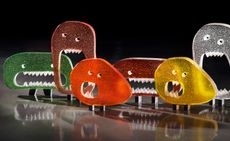 Lasvit’s little glass monsters win the prestigious Milano Design Award at Salone del Mobile
Lasvit’s little glass monsters win the prestigious Milano Design Award at Salone del MobileBy Catherine Shaw Last updated